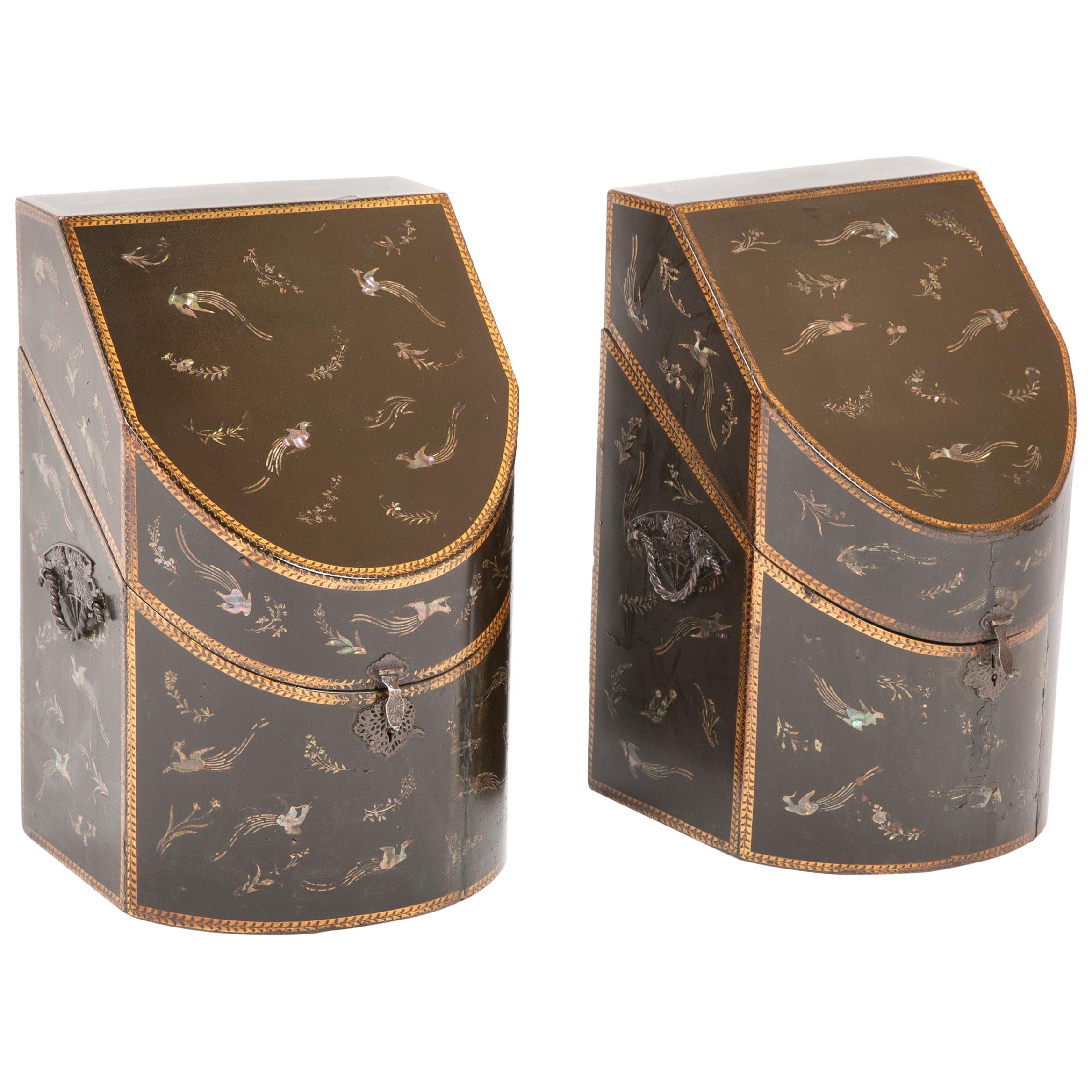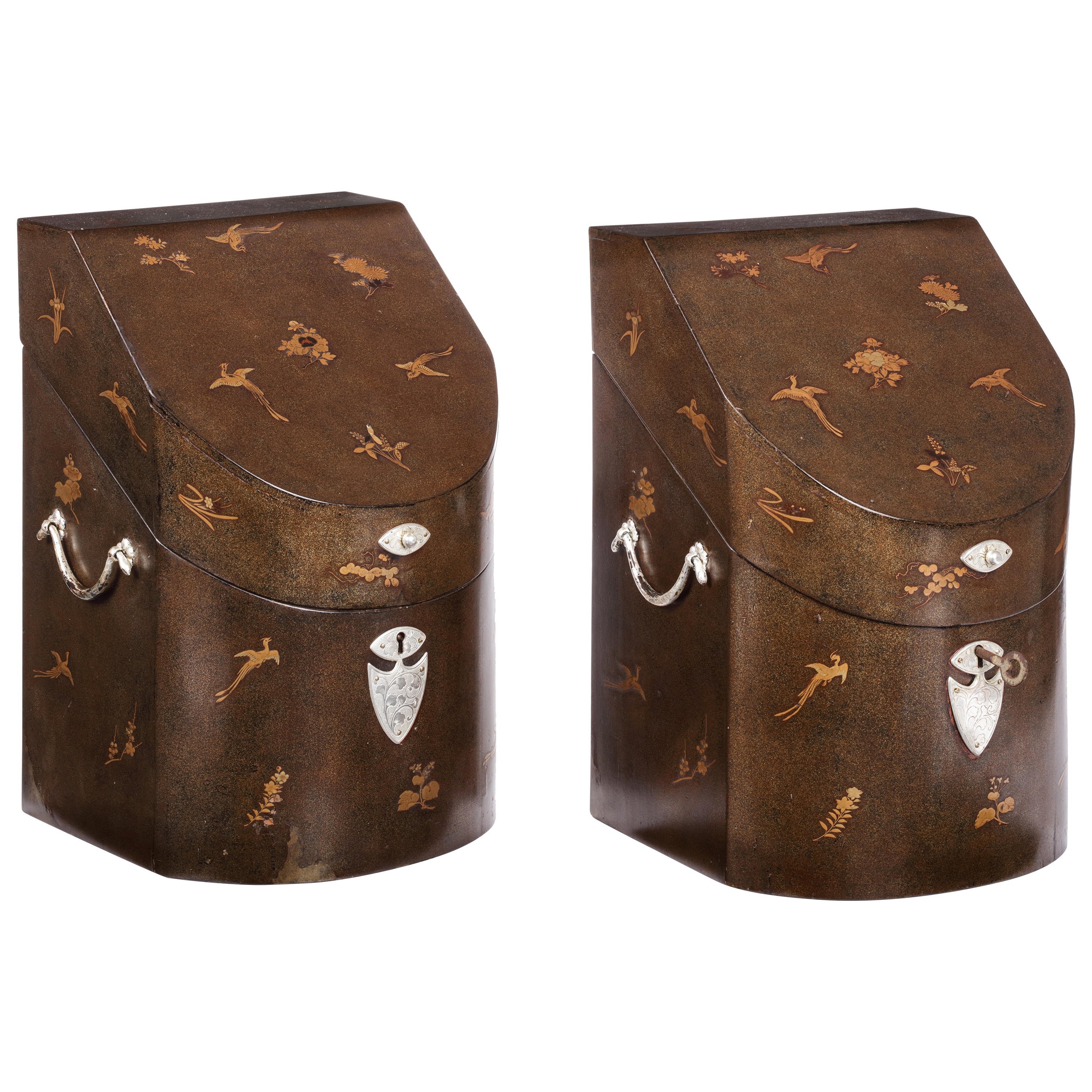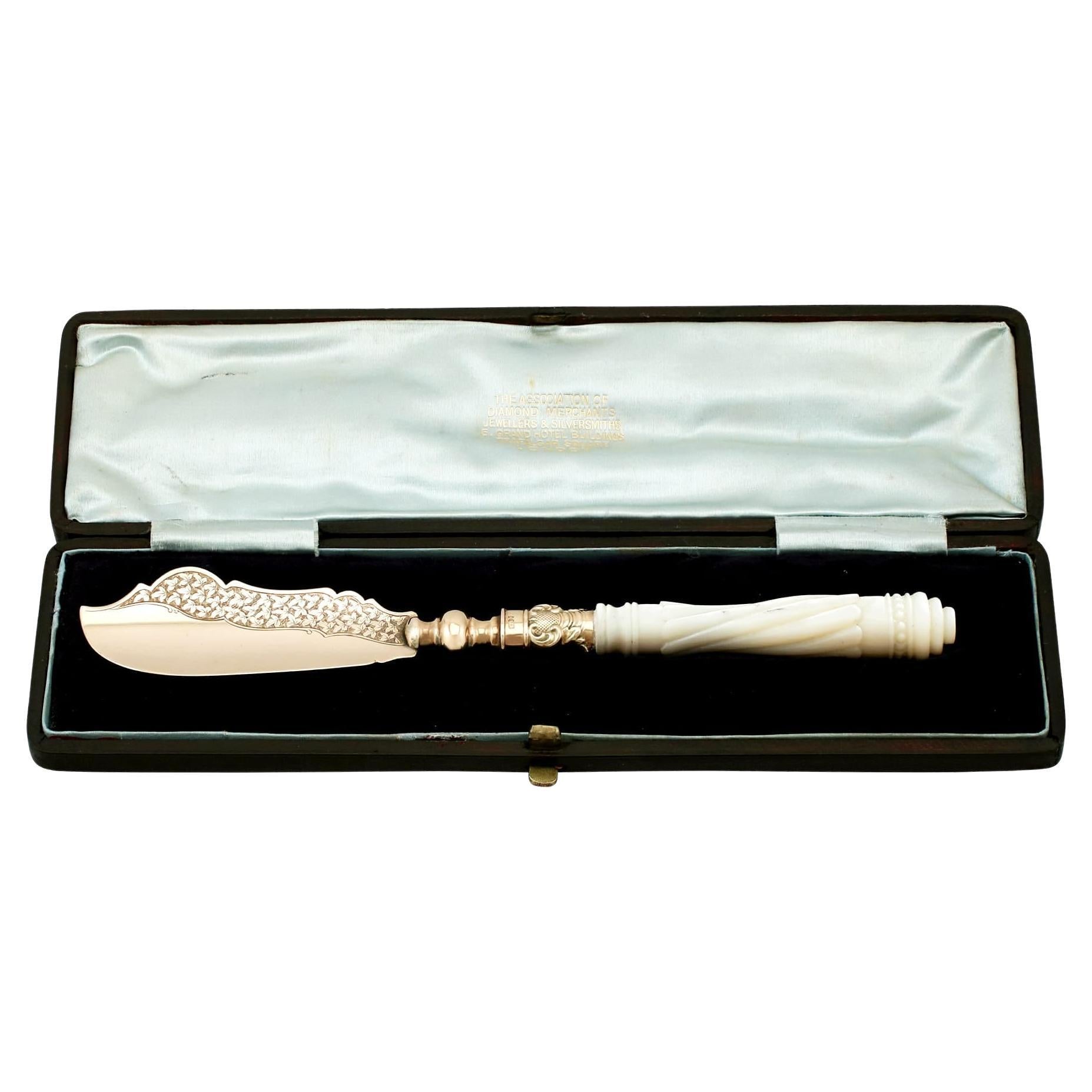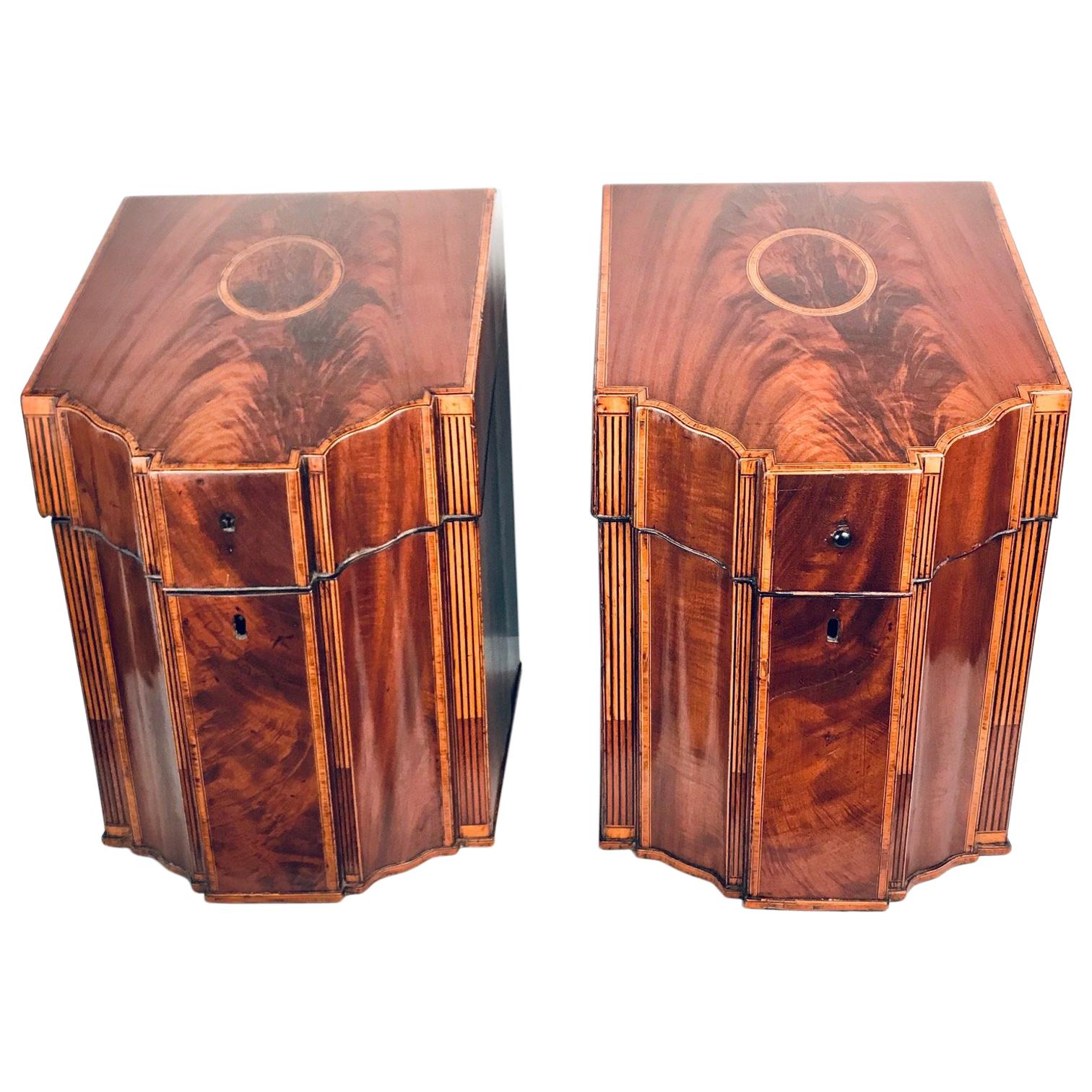Items Similar to Pair of Japanese Lacquer and Mother-of-Pearl Inlaid Knife Urns, circa 1800-1815
Want more images or videos?
Request additional images or videos from the seller
1 of 3
Pair of Japanese Lacquer and Mother-of-Pearl Inlaid Knife Urns, circa 1800-1815
About the Item
A rare pair of Kyoto-Nagasaki style lacquer and mother-of-pearl inlaid knife urns
Edo period, early 19th century
Measures: Height 71 x diameter 30 cm
?Formed as urns with vertically lifting covers and elongated finials, revealing fitted green velvet lined interiors for knives, decorated overall with birds, flowering stems, faux-fluting and oval panels with landscapes. The square plinth is raised on four bracket feet. Inside the lifting cover of one of the urns are Japanese characters, supposedly indications of some code by the craftsman.
A closely related knife urn, now in the collection of the Peabody Essex Museum, Salem (inv. E 73115), was acquired in Nagasaki by Captain Samuel Gardner Derby of the Margareth of Salem in 1801. Captain Gardner Derby traded in Nagasaki under charter from the VOC (Vereenigde Oostindische Compagnie), the Dutch East India Company. Between 1797 and 1814 Holland was occupied by the French and from 1811 until 1816 Java by
the English. During these periods practically no Dutch shipping was possible between Holland and Batavia (Jakarta) or between Batavia (Jakarta) and Nagasaki. To maintain a minimum amount of shipping between Batavia (Jakarta) and Nagasaki, between 1797 and 1807, the VOC chartered mainly American ships. American captains and officers ordered and bought mainly lacquered furniture in an American-English style, completely different from what the Dutch up till then had ordered. The present knife urns were possibly also ordered and acquired by Captain Gardner Derby during his stay in Deshima/Nagasaki in 1801.
Another similarly neoclassical shaped knife urn in the collection of the Ashmolean Museum Oxford (inv. 1996.17) appears to be signed by woodworker Kiyotomo koreo tsukuru (Kiyomoto made this). The same name, together with an address in the Sanjo-Teramachi District of Kyoto, has been found inside a fragmentary urn in a private collection. This is an indication that European-style furniture was not only lacquered in Japan but made there as well. This undoubtedly is not only true for knife-urns, but all European- style furniture lacquered in Japan after circa 1800 was made by Japanese furniture makers, after European models or drawings.
- Dimensions:Height: 27.96 in (71 cm)Diameter: 11.82 in (30 cm)
- Sold As:Set of 2
- Style:Anglo-Japanese (Of the Period)
- Materials and Techniques:
- Place of Origin:
- Period:
- Date of Manufacture:1800-1815
- Condition:Wear consistent with age and use.
- Seller Location:Amsterdam, NL
- Reference Number:1stDibs: LU5458226435782
About the Seller
5.0
Vetted Seller
These experienced sellers undergo a comprehensive evaluation by our team of in-house experts.
Established in 1985
1stDibs seller since 2020
19 sales on 1stDibs
Typical response time: 3 hours
- ShippingRetrieving quote...Ships From: Amsterdam, Netherlands
- Return PolicyThis item cannot be returned.
More From This SellerView All
- Pair of Fine Japanese Export Lacquer Cutlery Knife Boxes, 18th CenturyLocated in Amsterdam, NLA pair of fine Japanese export lacquered cutlery boxes Kyoto or Nagasaki, late 18th century H. 33.5 x W. 24 x D. 21 cm The bow-fronted boxes with sloping lids flat at the top are made of hinoki wood (Cypress), coated with Japanese paper and decorated in lacquer with scattered gold birds and flowers on a nashiji background. The Japanese mounts are made of copper and both boxes still have internal partitions to keep the cutlery upright. The form of these boxes is similar to a pictorial-style knife box in the collection of the Groninger Museum (inv. 1989- 347), dated between 1730 and 1780, but the style of the decoration is more like that on a knife box in the Peabody Essex Museum in Salem (inv. E62271), which was brought to Salem by James Devereux, Captain of the Franklin, in 1799. Provenance: Henriette Jeane Christine van Neukirchen, called Nyvenheim (1807- 1849) and Nicolaas Johan Steengracht van Oostcapelle (1806-1866), thence by descent to the last owners, Ludolphine Emilie baronesse Schimmelpenninck van der Oye (1944) married in 1969 to Roland Daniel van Haersma Buma (1944), the last residents of castle Duivenvoorden near Voorschoten and the great-great-granddaughter of Nicolaas Johan Steengracht van Oostcapelle. There is no evidence that Nicolaas Johan himself, or any of his or his wife’s ancestors had ever been in Japan. However, Nicolaas’ grandfather (Nicolaas Steengracht, 1754-1840) was a director of both the VOC and WIC (West Indies Company...Category
Antique Late 18th Century Japanese Lacquer
MaterialsSilver
- Mother-of-Pearl Black Lacquer Japanese Export Table with Feet Shaped as BatsLocated in Amsterdam, NLA Japanese export lacquer tripod table with feet shaped as bats Nagasaki, 1850-1860 H. 73 x diam. 108 cm The six-lobbed top is decorated with reverse-painted mother-of-pearl in a sprawling motif of plum blossom, bamboo, and peonies, surrounded by fluttering sparrows enhanced by details in maki-e. The table, made to appeal to a foreign audience, incorporates a curious mixture of seasonal references. In addition to the decoration of foliage from late winter and spring, the column is decorated with grapes and a rabbit pounding rice, both Japanese motifs for autumn and the month of September. The feet, shaped like bats that almost appear to wake up from hibernation, symbolise luck and happiness in Japan. The present flamboyant Nagasaki-style table is depicted in the Asada workshop drawings of 1856. These drawings, titled Aogai makie hiinagata hikae (memorandum of designs for lacquer with inlaid pearl...Category
Antique 19th Century Japanese Lacquer
MaterialsLacquer
- Fine Japanese Export Red Lacquer Box with Masonic Symbols, circa 1800Located in Amsterdam, NLA fine Japanese export red lacquer box with Masonic symbols Kyoto/Nagasaki, 1800-1820 Red lacquer decorated with scattered flowers and flying birds with long tails in gold, wit...Category
Antique Early 19th Century Japanese Edo Lacquer
MaterialsGold
- Extremely Fine and Rare 17th-Century Japanese Export Lacquer and Inlaid CabinetLocated in Amsterdam, NLAn extremely fine and important Japanese lacquer cabinet with gilt-copper mounts for the European market Edo period, late 17th century The pictorial style decorated rectangular...Category
Antique Late 17th Century Japanese Lacquer
MaterialsBrass
- Japanese Nagasaki Export Lacquer Box with Depiction of the 'Trippenhuis'Located in Amsterdam, NLA Japanese Nagasaki export lacquer box with mother-of-pearl depiction of the Amsterdam ‘Trippenhuis’ Edo-period, circa 1830 H. 12.5 x W. 24 x D. 15 cm ? The house depicted on t...Category
Antique 19th Century Japanese Edo Lacquer
MaterialsMother-of-Pearl, Lacquer
- Japanese Colonial Nagsaki Lacquer Box with Depiction of Amsterdam, 1830-1840Located in Amsterdam, NLAn important Japanese lacquer box with a view of The 'Nieuwe Stadsherberg Van Amsterdam Nagasaki, Edo-period, 1830-1840 The black lacquered wood box, decorated in gold and inla...Category
Antique Early 19th Century Japanese Decorative Boxes
MaterialsMother-of-Pearl, Wood
You May Also Like
- Rare pair of Japanese Nagasaki Export Lacquered Wood Knife BoxesLocated in Stamford, CTRare pair of Japanese Nagasaki Export lacquered wood knife boxes with mother-of-pearl inlay of flowers and birds, now converted to letter boxes. The boxes were converted to letter b...Category
Antique Early 19th Century Japanese Anglo-Japanese Knife Boxes
MaterialsWood
- Victorian Gold and Mother of Pearl Handled Butter KnifeBy George Unite & SonsLocated in Jesmond, Newcastle Upon TyneAn exceptional, fine and impressive antique Victorian English 9-carat yellow gold and mother of pearl handled butter knife, boxed, an addition to our diverse flatware collection. This exceptional antique Victorian 9-karat gold butter knife has a sabre style knife blade, with a broad incurved shaped form. The anterior face of the concave curved blade is ornamented with a segmented panel of impressive bright cut engraved foliate ornamentation, all on a matte background. The reverse surface of the blade is plain, apart from the feature hallmarks. This antique knife retains the original, fine and impressive carved mother of pearl handle...Category
Antique 1890s English Victorian Knife Boxes
MaterialsGold
- 19th Century Pair of Knife Boxes With Mother of PearlLocated in Charlottesville, VAA most unusual pair of knife boxes. Beautiful decoration.Category
Antique 19th Century British Knife Boxes
MaterialsMother-of-Pearl, Wood, Paint
- 1894 Thompson Jewelers Mother of Pearl Fruit KnifeLocated in Coeur d'Alene, IDSterling fruit knife with mother of pearl handle, etched back strap, marked from his Godfather 1894 with hallmarks. In original box marked "GWNAE THOMPSON, LTD JEWELERS." Period: circa 1890 Origin: England Size: Knife 3 1/2" extended 6" In England silver fruit knives...Category
Antique 1890s English Sterling Silver
MaterialsSterling Silver
- Pair of George 111 Inlaid Mahogany Knife BoxesLocated in Montreal, QCThis fine pair of Classic proportions have many marks of quality. The timber used on the sloped fronts has been carefully selected with figured grain conforming to the shape of the h...Category
Antique Early 19th Century British George III Knife Boxes
MaterialsMahogany
- Pair Antique English Mahogany Knife & Fork Cutlery Urns / Boxes, Circa 1910-1920Located in New Orleans, LAPair antique English mahogany knife and fork cutlery urns / boxes, Circa 1910-1920. Exceptional size.Category
Early 20th Century Urns
MaterialsMahogany
Recently Viewed
View AllMore Ways To Browse
Antique Style Furniture
Japanese Used Furniture
Pair Lacquer
Antique Japanese Furniture
Japanese Furniture Antique
Japanese Antique Furniture
Japanned Antique Furniture
Pair Of Lacquer
French Furniture Lacquered
French Lacquer
Lacquer Signed
French Wood Lacquer
Lacquer Company
Lacquered Panel
Lacquer Furniture Green
Lacquered Furniture Green
The Lacquer Company
Pair Of Plinths





